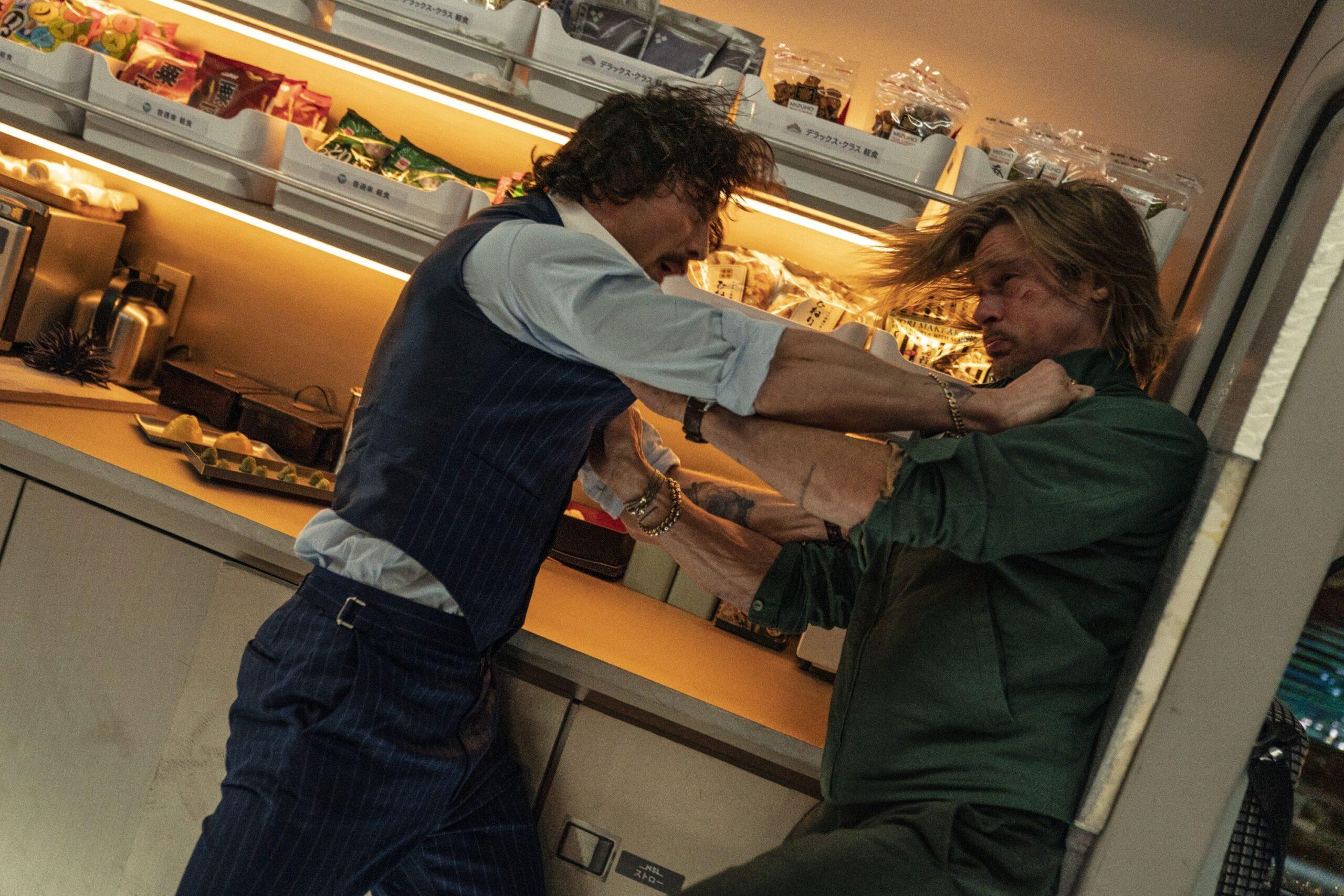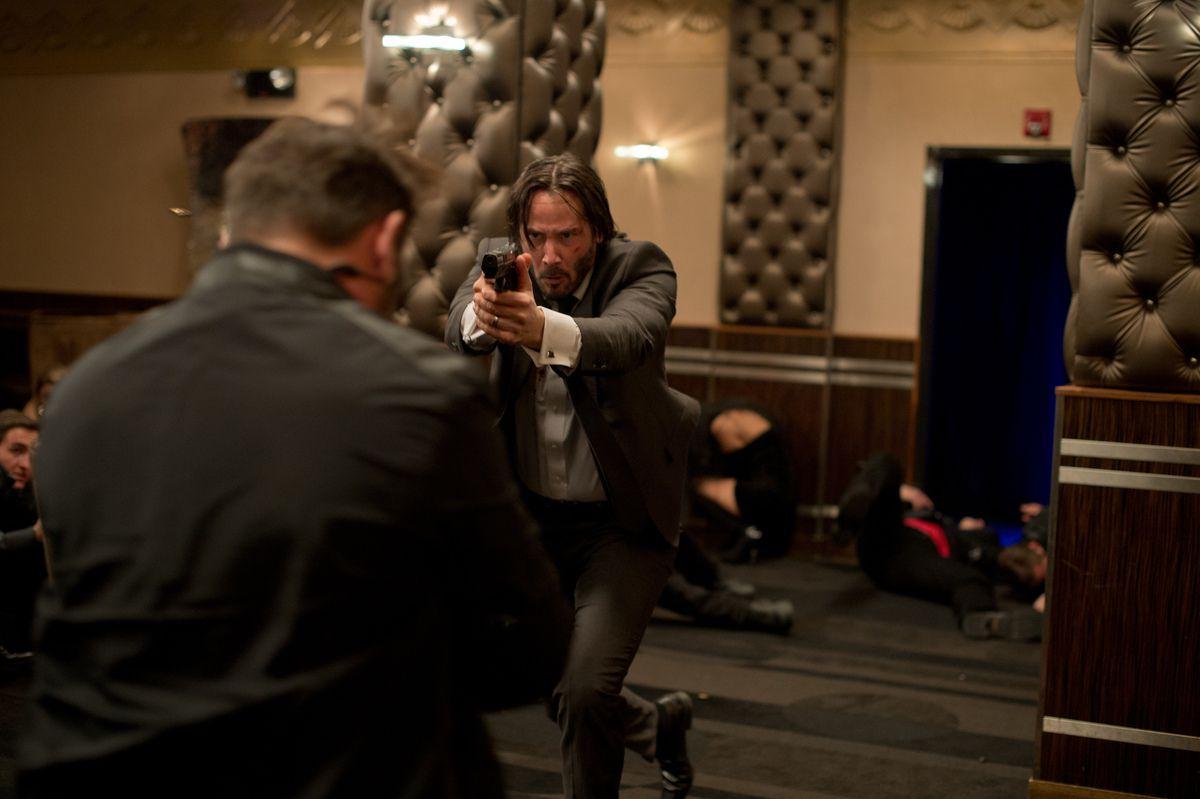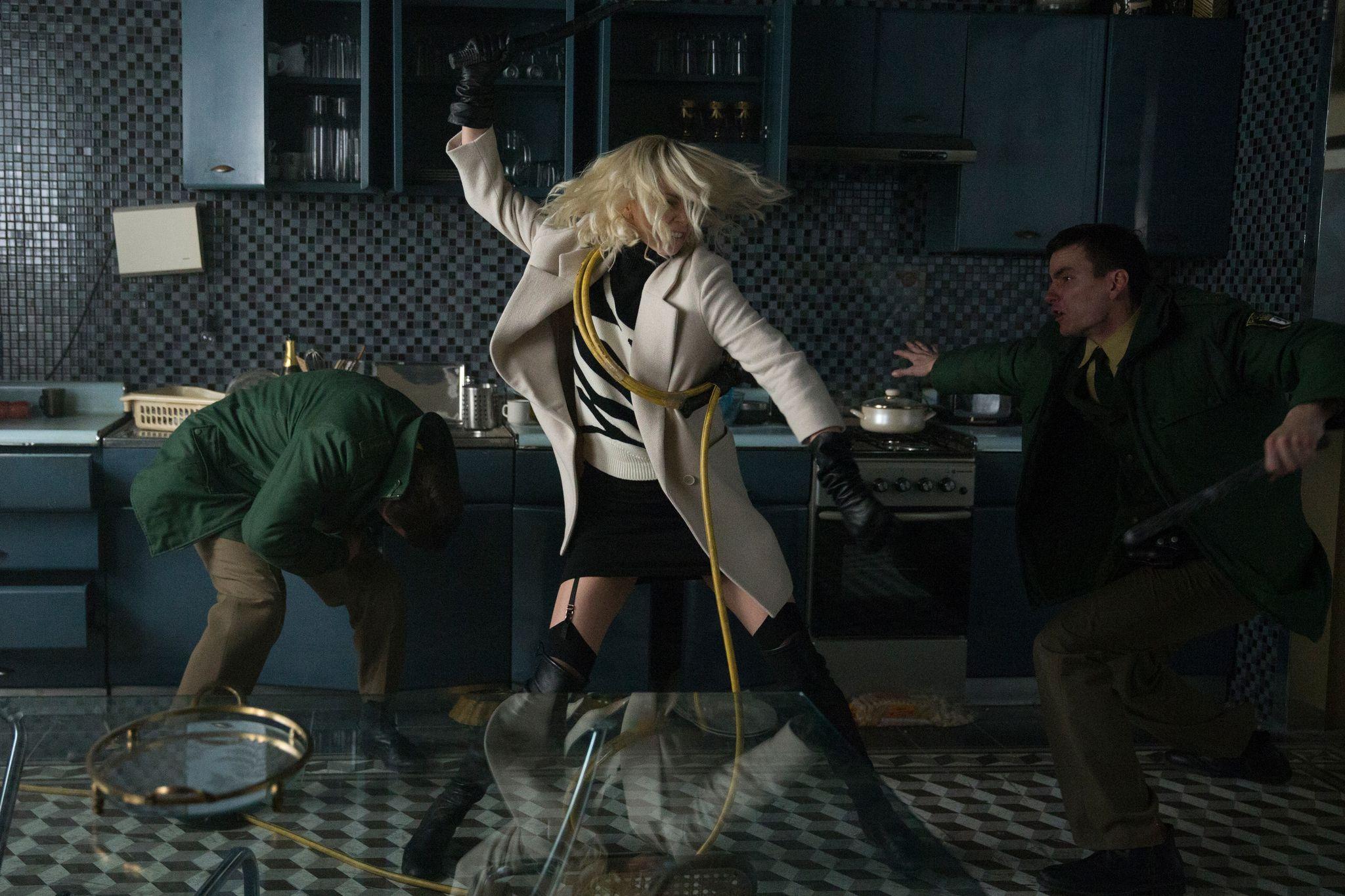How David Leitch Became the King of Hollywood Action
Since co-directing 2014’s ‘John Wick,’ the stuntman turned director has revamped what action movies look like, with star vehicles for everyone from Brad Pitt to Charlize Theron to Ryan Reynolds“What about that guy?”
With those four words, David Leitch’s life changed. Just a year or so earlier, the recent college graduate was beginning his career as a teacher in Minneapolis, Minnesota. Now he was performing as a stuntman on David Fincher’s Fight Club. Production was underway, and yet, somehow, there was still no stunt double for Brad Pitt. Having only recently gotten his Hollywood break on the straight-to-video action thriller Perfect Target, Leitch was on set training a few actors in fighting techniques when he noticed someone pointing at him. “They stood us next to each other,” Leitch recalls, “and “Brad’s like, ‘Yeah, what about this guy?’”
By the end of Fight Club, Leitch was Pitt’s guy. Over the next decade, he would act as the man pretending to be the man on The Mexican (don’t ask about the car he crashed), Ocean’s Eleven, Troy, and Mr. & Mrs. Smith. But Leitch had dreams of being the guy—behind the camera at least. He gradually worked his way up the call sheet, putting together action sequences as a stunt coordinator and then serving as a different type of backup as second unit director for Oscar-nominated filmmakers James Mangold and Adam McKay, before getting his own shot as codirector of surprise triumph John Wick. Eight years later, Leitch is sitting at the top of the Hollywood mountain, with stars from Keanu Reeves to Charlize Theron to Ryan Reynolds to Dwayne Johnson all lining up to make him their guy.
Having now emerged as the premier action director for Hollywood’s A-list, Leitch will come full circle this Friday, reuniting with Pitt for the violent, stylish, hilarious, crowd-pleasing blockbuster Bullet Train, in which Pitt stars as Ladybug, an unlucky assassin whose latest job puts him on a nonstop collision course with a group of colorful, skilled adversaries. “This one is special for us,” admits Leitch, who looks at his fifth feature film as his first “complete expression” of himself as an artist.
“It’s a crazy story—and just too cool. The stuntman is usually helping you fill out your role and make it look better, and now I’m playing my piece in his puzzle,” says Pitt. “I’m really impressed, and really proud of him, because that just doesn’t happen.”

Since he arrived in Los Angeles in the late ’90s, Leitch hasn’t slowed down—in fact, he’s only sped up. The 46-year-old filmmaker’s main residence is in Henderson, Nevada, but he and his wife/producing partner Kelly McCormick prefer to live on movie sets. From 2017 to 2019, they released a big-budget hit in three consecutive years, with Atomic Blonde, Deadpool 2, and Fast & Furious Presents: Hobbs & Shaw combining to gross over $1.6 billion at the worldwide box office—and cementing Leitch’s place as one of the go-to tentpole shepherds.
Fresh off a whirlwind European press tour that featured stops in London, Paris, and Berlin, Leitch is now finally managing to take a break long enough for a conversation from his “L.A. crash pad” in the Hollywood Hills. “We do line them up back-to-back, and if we’re not directing one, then we’re producing one,” he says of the busy schedule with McCormick, whom he credits with taking the wheel of their company 87North Productions. “I really just love making movies; it’s our hobby, it’s our job, it’s our passion, and that’s very rare for people. Even when we’re unwinding, we’re reading scripts or looking at cuts of movies we’re producing. We’re having so much fun. Don’t get me wrong, it’s hard work and it comes with its stressors and anxiety, but it’s really a joy. I do think it took so long to get here [that] I just want to make every opportunity count.”
Leitch’s proclivity for continuous movement began at a young age. The son of two teachers, he grew up in a Wisconsin town that was so small that one school housed kindergarten through 12th grade. With only 40 students in his entire class, everyone had to participate in the extracurricular activities, or they’d be ostracized. That meant he was a multisport jock, a musician, a martial artist, and a theater kid. Like now, he was rarely home, but when he was, the self-proclaimed “HBO baby” was glued to the network’s airings of Die Hard and Lethal Weapon, as well any and all martial arts movies he could find.
Leitch’s passion for martial arts brought him to Los Angeles, where he’d come during college summer breaks to train with famed instructor Dan Inosanto, a comrade of the legendary Bruce Lee. He soon met a fellow trainee, Chad Stahelski, who had just broken into the stunt world as the double for the late Brandon Lee on The Crow. After graduating from college, Leitch was planning on following in his parents’ footsteps, but then he got a call from Stahelski with an offer to fly to Mexico to work as a stuntman on Perfect Target, which starred Bloodsport 2 lead Daniel Bernhardt. (Bernhardt now appears in all of Leitch’s movies with the sole purpose of being quickly killed off.) “I worked on that movie for a couple weeks, it was a non-union thing,” Leitch says. “And I was like, ‘Wait a minute, we get to make up fight scenes and get paid?’ Chad’s like, ‘Yeah,’ and I’m like, ‘I’ll be right back.’” Leitch flew back to Minneapolis, packed up his car, and never looked back.
From the moment he arrived back in L.A., Leitch and Stahelski were partners—in training, in stunts, in basically everything. “We were both martial arts nuts, Jackie Chan nuts,” Leitch says. “We would train martial arts, train trampoline, train anything we could involving stunts. We dug a hole in the backyard and put a trampoline in it and bought porta-pits to fall off the roof. We were just teaching ourselves to be stuntmen, trying to break into the business, being prepared for that chance.”
Even with that type of drive and the brief experience on Perfect Target, they found that the lack of a mentor with their own footing in the industry held them back. But Fight Club proved to be the game changer. Leitch caught on with Pitt just as he was becoming the biggest movie star on the planet, while also regularly doubling for Jean-Claude Van Damme. “Those were my two guys,” Leitch shares with a laugh. From there, work started to come in, with stunt gigs on The Bourne Ultimatum, where he backed up Matt Damon, and The Matrix sequels, where Stahelski served as the stuntman for Keanu Reeves. But Leitch was “really trying to go to the next level.” By the time he was on the set of Mr. and Mrs. Smith with Pitt, he had served as the second-unit director and stunt unit coordinator on Van Damme’s In Hell and was attempting to put together his own project. “I was pitching Brad on Mr. & Mrs. Smith, like, ‘Hey man, I’m shooting this short, if you’re into it,’” Leitch recalls. “And he’s like, ‘Hmm. You want to be a director?’ I’m like, ‘Yeah,’ and he’s like, ‘Yeah, yeah, cool.’ I think in his mind, he’s like, ‘Good luck, Jesus Christ.’”
Leitch never heard back from Pitt about that offer, but he was able to secure the other star of Mr. and Mrs. Smith, Angelina Jolie, for a cameo in the action-comedy mockumentary Confessions of an Action Star, which chronicled the rise and fall of a Chippendales dancer turned action star Frank Sledge. Leitch wrote the script—and starred as Sledge. “I learned quickly that I’m not an actor,” Leitch jokes of the film that debuted at Sundance in 2005 before getting a small release in 2009. “But I really appreciate the experience, because to understand the actor and empathize with their struggle is important.”
With a career in front of the camera indefinitely on hold, Leitch branched away from being Pitt’s guy and graduated to being an in-demand stunt coordinator and fight choreographer, as well as a second-unit director on blockbusters like Anchorman 2: The Legend Continues, The Wolverine, and Teenage Mutant Ninja Turtles. Meanwhile, Stahelski had risen to the same rank on The Hunger Games, The Expendables 2, and After Earth. But they felt like they’d hit a ceiling—Leitch knew that it had been decades since decision-makers viewed second-unit directors as potential main directors. Luckily, there was a vocal and persistent champion in their corner. Before she married Leitch in 2014, McCormick managed him and Stahelski, while also helping package and produce Oscar-nominated films like Whiplash, Hell or High Water, and Manchester by the Sea. “There weren’t many people looking at us, because they’re like, ‘Yeah, but can they tell a story?’” Leitch says. “And she’s like, ‘Have you seen the action scenes that are so memorable and iconic? Do you understand why they’re memorable and iconic? It’s because they tell a story.’”
Still, breaking down that final door was a challenge. With the Reeves-led John Wick in development, McCormick landed Leitch and Stahelski a meeting to discuss directing just the action scenes. Leitch and Stahelski concluded that the gig was too small for them, considering their other grander-scale second-unit jobs, but McCormick suggested they write Reeves a letter with a simple and clear message: “We’d love to do this movie, but it’s time for us to direct.” Stahelski presented the note to Reeves, who gave his full support. Lionsgate wasn’t as convinced, however. While they hired Leitch and Stahelski as a directing team, the studio wouldn’t commit to a domestic theatrical release and only approved a budget of roughly $15 million.
Leitch credits their established relationship and trust with Reeves for the success of the film and how they were able to coax a career-defining performance out of him. “If an actor trusts you and you can provide a safe place, they’re going to go places they wouldn’t have gone before,” he says. “Not that Keanu wouldn’t not cry, but the fact that we took him to that level … he’s a cold-blooded assassin who is crying in the first 10 minutes of the movie. He really trusted us. If it wasn’t going to work, we weren’t going to use it, but we wanted to go there.”
“They didn’t feel like first-time filmmakers,” Reeves said in 2014. “I felt really comfortable, confident, and responsible; I didn’t want to let them down, because they had such a vision.”
But as it so often goes, the future isn’t apparent until it’s undoubtedly arrived. “We showed it to Lionsgate, and they don’t get it,” Leitch says. “They show it to some distributors and buyers for the domestic market—no offers.” The company was readying a straight-to-video release when they decided to try one last test option and screened it at Austin’s popular genre film festival Fantastic Fest. “The audience goes bananas,” Leitch says with a sly smile. “We knew we made a movie for genre fans, and we were just waiting for genre fans to actually see it, not just the bean counters.” After the rapturous reception in September 2014, John Wick earned a sudden theatrical release date. Armed with strong reviews, John Wick overperformed box office expectations, grossing almost $90 million worldwide and setting up a franchise that can’t be killed, with a fourth film from Stahelski and television series on the way in 2023.
Not only did John Wick become a phenomenon in itself, it changed an entire genre. Like Liam Neeson did for men of a particular age with Taken, now every actor of a certain stature wants their Wick. Just look at Ryan Gosling and The Gray Man, or Jessica Chastain and Ava, or Mark Wahlberg and almost every movie he’s done in the past decade. With the prototypical, buffed-out star from the ’80s and ’90s gone, the key ingredient has shifted from those doing the fighting to those crafting it. Leitch, Stahelski, and other stuntmen-turned-directors like Extraction’s Sam Hargrave, are responsible for some of this era’s most popular and respected action films and have reinvigorated the genre—in part by emphasizing longer takes, wider shots, and quicker cuts. “I don’t think he could avoid putting his own stamp if he tried,” Ryan Reynolds says of Leitch. “[He] is so signature in his look and feel, you see it from the opening frame to closing.”
That signature look and feel is “guiding the audience visually,” according to Leitch, who thinks his years shooting strictly action sequences has helped him perfect how to communicate a nonverbal narrative. “I was telling stories through physicality,” he says, “and you don’t really get dialogue. A lot of times you don’t even have the actors, so you have to be even sharper as a storyteller.”
But after finally managing to transition away from his time as a stuntman, the hits on Leitch didn’t stop. A ruling from the Directors Guild of America meant that Stahelski alone would be listed as the John Wick director, with Leitch instead being billed solely as a producer. Despite that disappointing speed bump, Leitch and Stahelski were already cooking up ways to expand the John Wick universe and were both attached to the sequel, as well as Atomic Blonde, an action spy thriller set in Germany on the eve of the collapse of the Berlin Wall. However, the schedules of Reeves and Atomic’s star Charlize Theron didn’t match up, meaning a decision had to be made. “I was way more excited about Atomic Blonde than Chad was,” Leitch says. “God, I’m so grateful that that moment happened … Chad got to take care of this world that we curated together and expand it, and I got to go down this other road of collaborating with all these people that I like to collaborate with.”
The decision to step out on his own immediately paid off. Atomic Blonde garnered equal praise for its boldly distinct and stylish look, movie-star performances from Theron and James McAvoy, and an ambitious, 10-minute one-shot fight scene featuring Theron’s Lorraine Broughton giving—and taking—a beating in a stairwell that has been deemed a true feat of action filmmaking by fans, stuntpeople, and actors alike. “It was Kelly’s idea to do the oner, and she’s like, ‘Now you got to go pitch it to Charlize,’” Leitch remembers, laughing. “So I say, ‘Here’s the deal: We don’t have a lot of money on our movie, I want to do something that’s special and I want to hang it on the Academy Award winner. The camera’s never going to leave you for 10 minutes. It’s all you—you’re going to do this whole fight.’ And she was like, ‘What?’”
Like Reeves, Theron trusted Leitch, and the results spoke for themselves: Atomic Blonde surpassed the box office total of John Wick, set the Oscar winner up with the first potential franchise that she could call her own, and forced other movie stars to quickly take notice. “Deadpool 2 was a summer movie which needed a bit more scope and scale than the first film,” says Reynolds, who, after spending more than a decade trying to put together a Deadpool movie, had only two years to replicate the record-breaking success of 2016’s first effort. “But that wasn’t why I wanted to work with Leitch. In our first meeting, most of what interested him was the character’s vulnerability. That was the real brilliance of Leitch. He understood that from the jump and brought it out of every moment.”
On his end, Leitch says his process for selecting projects is “very calculated,” but that it also comes down to material, and that’s how Deadpool 2 unexpectedly became too enticing to pass up. “I would’ve never said, ‘I want to go out and direct a superhero sequel,’” he says. “But when the offer came for Deadpool 2, it was undeniable … I was excited that I would get to play in that sandbox, like ‘Ooh, irreverent comedy, that would be fun.’”
It was a similar reaction when the idea of a Fast & Furious spinoff starring Dwayne Johnson and Jason Statham came across his desk. “This bell went off in my head, like, ‘This is like Lethal Weapon,’” he says. “I knew the expectations were high, but I was like, ‘Let’s do it.’” And the enthusiasm went both ways. “Instead of thinking of whatever the biggest explosions are with the biggest vehicles and let’s drop them from the moon, this is where finding the perfect director comes in with a very unique point of view and perspective, and someone who understands not only action but understands stylistic action mixed in with story and character. And then enters David Leitch,” Johnson told me in 2018 during filming of Hobbs & Shaw. “[As] he just did with Deadpool and John Wick and Atomic Blonde, you can see the stylistic approach that David has, and he really just stepped up to the plate and took great ownership of this spinoff. When we made the announcement that David was coming onboard, it was almost like the final magical ingredient that fans’ heads exploded, just like, ‘Yes, that’s the guy!’”

As his filmmaking career exploded, Leitch formed 87North Productions with McCormick, producing mid-budget action films like Bob Odenkirk’s John Wick–like hit Nobody and the upcoming Violent Night, which Leitch says is “Santa having his Die Hard moment.” But 87North also operates a stunt training and design studio in Hollywood that Violent Night star David Harbour trained at and nicknamed “The Church of Pain.” The dedication from the Stranger Things actor is the latest example of the buy-in Leitch has elicited from talent, coming on the heels of Pitt reportedly doing 95 percent of his stunts on Bullet Train. “You know exactly what the 87North résumé is and you don’t want to come in there and half-ass it,” says Tony and Emmy nominated actor Brian Tyree Henry.
“David has his own language in cinema and it leans into the world of that Jackie Chan, Buster Keaton kind of action-comedy,” Henry’s Bullet Train costar Aaron Taylor-Johnson adds. “87North, you just sign up.”
At this point, Leitch hopes that any actor signing on to make a movie with him knows what is expected, but that doesn’t mean he can’t bail them out if needed. “I’ll be honest, when someone can’t do something, I have a bag of tricks from 20 years of shooting action, and I’ll use them,” he admits. “And there’s another layer of trust. Like, ‘Go for it, if you don’t get it, I got a backup plan, and you’re going to look just as great.’”
It also doesn’t hurt when you have some of the biggest stars in the world becoming repeat customers. “David has a kind of ‘fighter pilot’ calm about him,” says Reynolds, who re-upped with Leitch for an extended Hobbs & Shaw cameo. “Spend five minutes with the man and you trust him with your life … We were up against an impossible deadline for Deadpool 2. Our postproduction process was brutally contracted. We pretty much lived together for over a year. Having worked with him on two films now, I feel like we have a connection that’s forged in fire … Above all, I trust this man. Implicitly. And I’ve been around long enough to know the value of that.”
“I think it comes from years of being a below-the-line journeyman in the business, having to understand everybody else’s job and everyone else’s perspective on the director and what this asshole is thinking,” Leitch says when asked how he’s built such ride-or-die respect from actors. “There’s so many people supporting your vision, and I know when I’m trying to support somebody’s vision, I want to be heard and understood so I can make adjustments so they can get what they want.”

He may not have secured Brad Pitt for that cameo in his short, but when it was time for Bullet Train, Leitch finally landed his guy, as well as a loaded cast that includes Henry, Taylor-Johnson, Joey King, Hiroyuki Sanada, Zazie Beetz, Andrew Koji, Michael Shannon, Bad Bunny, and Sandra Bullock.
There has to be a bit of fate in the fact that Leitch and Pitt’s reunion on Bullet Train began only months after the actor won an Oscar for Once Upon a Time in Hollywood, in which Pitt played the ever-loyal stunt double to a Hollywood star. “We spent so many years where I was supporting him building characters, and when we came around full circle, it was really great to see him at the top of his game, building a character to support my movie,” Leitch shares. “We fell right back into our banter. But there was definitely a different respect when we got to that level; he saw me as a filmmaker.”
Bullet Train is only days away from release, but Leitch is already on the move again. He hardly ever left the Sony lot in Culver City during production on Bullet Train, so he’s thankful to be back in his element and splitting his time between taking part in the film’s massive global promotional push and traveling back and forth to Australia for preproduction on his remake of the popular ’80s series The Fall Guy. That’s right: Leitch is finally making his stuntman movie. And taking over Lee Majors’s iconic role of Colt Seavers, a Hollywood stuntman who moonlights as a bounty hunter, is, of course, another A-lister in Ryan Gosling. “It’s something that I’ve wanted to do for a long time,” Leitch says, not wanting to give away too many details. “It’s going to be good, fun, summer fare with a lot of action and some unexpected things.”
Speaking of the unexpected, Leitch is set to direct all six episodes of Hot Air, a limited series that will star recent Emmy and Oscar nominee Andrew Garfield as renowned British entrepreneur Richard Branson. But even with these new projects on tap, the director isn’t ruling out a return for potential Atomic Blonde and Hobbs & Shaw sequels, which are currently being slowed by “bureaucratic tape” and “insane” schedules, respectively. Looking more likely is producing Nobody 2, and Leitch hopes he and McCormick can keep finding stories with “unconventional heroes,” whether that’s turning Odenkirk into a tough guy, Harbour into a violent Santa Claus, or Taylor-Johnson and Bad Bunny into superheroes, with both actors picking up their own Marvel films from Sony after executives got their eyes on early Bullet Train footage.
“I’m pinching myself right now,” Leitch says, literally pinching himself. “I’m very humbled by the actors who’ve come to the table to work with me … They’re the ones that are hanging it out there every day, and they’re the ones that are going to make you shine. Because whatever they’re doing in front of that lens is what we live and die for.”
It’s then that Leitch falls into an old habit: standing in for a Brad Pitt character. Sounding just like Ladybug, he starts talking about how fate is the only explanation. “It’s like in Bullet Train,” he says. “Everything that ever happened brought you here for this moment.”
Derek Lawrence is a Los Angeles–based writer covering TV and film. His work has also appeared in Entertainment Weekly, People, and Vulture.
